
Phyllota is an Australian genus from the family Fabaceae, a biological grouping of flowering plants.
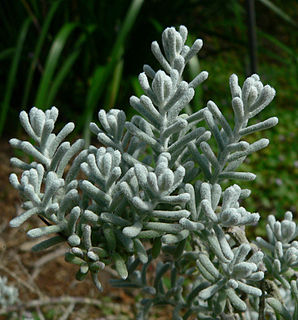
Maireana sedifolia, also known as the bluebush or pearl bluebrush is a compact shrub endemic to Australia, and found in New South Wales, Victoria, South Australia, Western Australia, and the Northern Territory. It is used in pasture and as a garden plant where it is popular due to its distinctive grey foliage.

Prostanthera lasianthos, commonly known as the Victorian Christmas bush, is a large shrub or small tree of the mint family, Lamiaceae, which is native to Queensland, New South Wales, Victoria and Tasmania in Australia. It grows up to 10 m (35 ft) high but is usually much less and is found in wet sclerophyll forests, often beside creeks. Its flowers, which appear in profuse sprays, are about 2 cm long and white or pale lilac, with purple and orange blotches in the throat. They appear in late spring and summer, and specifically around Christmas time in Victoria. The fragrant, toothed leaves are 4 to 12 cm long and about 1.5 cm wide.
Conospermum acerosum, commonly known as needle-leaved smokebush, is a shrub endemic to Western Australia

Sesuvium portulacastrum is a sprawling perennial herb that grows in coastal areas throughout much of the world. It is commonly known as shoreline purslane or (ambiguously) "sea purslane," in English, dampalit in Tagalog and 海马齿sl in chinese.

Grevillea bedggoodiana, commonly known as the Enfield grevillea, is a shrub that is endemic to Victoria, Australia. It is closely related to Grevillea obtecta and Grevillea aquifolium.

Callistemon 'Lilacinus' is a cultivar of the genus Callistemon. It grows to between 2.5 and 4 metres high and has purplish-violet inflorescences. Leaves are smooth and sharp pointed, with thick margins and are 40 to 100 mm long and 6 to 18 mm wide.

Adenanthos pungens, the spiky adenanthos, is a species of shrub in the family Proteaceae. It is endemic to the south-west of Western Australia.
Grevillea pachylostyla, commonly known as Buchan River grevillea, is a shrub species which is endemic to the upper reaches of the Buchan River in the eastern highlands of Victoria, in Australia.
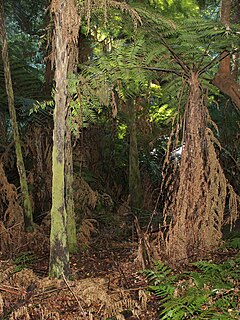
Alsophila leichhardtiana, synonym Cyathea leichhardtiana, the prickly tree fern, is a plant in the tree fern family, Cyatheaceae, found in eastern Australia. It is a common species found in moist situations, in and near rainforests. It was named in honour of the explorer and botanical collector Ludwig Leichhardt.
Grevillea stenobotrya is a shrub in the family Proteaceae. It is endemic to arid regions of Australia. Common names include rattle-pod grevillea, sandhill grevillea and sandhill spider flower. Plants grow to between 1.5 and 6 metres in height and have leaves are linear and entire, or occasionally divided, and between 6 and 28 cm long and 0.7 to 2.5 mm wide. Flowers are cream, pale yellow or pale pink. These appear in clustered spikes at the end of branches between May and December in the species' native range. The fruits which follow are hard, flattened and rounded and have a short beak.

Amyema maidenii is a species of flowering plant within the genus Amyema, an epiphytic hemiparasitic plant of the family Loranthaceae native to Australia and found Australia-wide in the inland.

Maireana pyramidata is a species of plant within the genus, Maireana, in the family Amaranthaceae. It is endemic to Australia, and widespread throughout Australia in the inland, where it is found in Victoria, New South Wales, Queensland, the Northern Territory and Western Australia.

Velleia connata is an erect annual herb in the family Goodeniaceae, and is found in all mainland states and territories of Australia. It grows on sandplains and stony hills in Beard's eremaean province. Its flowers are yellow-brown or white-pink and it flowers mainly from February or May to October.
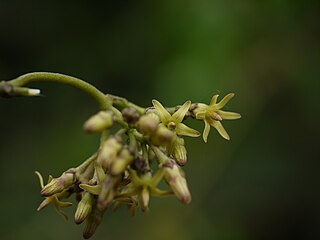
Parsonsia alboflavescens is a woody vine of the family Apocynaceae, found from tropical and subtropical Asia to Northern Australia. In the Northern Territory of Australia, where it occurs in Arnhem Land, it has been declared "near threatened".

Decaisnina brittenii is a species of flowering plant, an epiphytic hemiparasitic plant of the family Loranthaceae native to the Northern Territory, Queensland and northern Western Australia.

Waltheria virgata is a species of flowering plant in the mallow family, Malvaceae, that is found in the north of Western Australia, and in the Northern Territory.
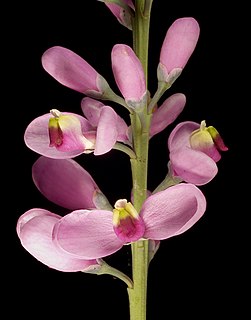
Comesperma virgatum, commonly known as milkwort, is a herb in the family Polygalaceae. It is an erect slender herb growing to between 30 cm and 1.6 m high, on sandy and lateritic soils, and sometimes in swampy conditions. Its pink to purple flowers may be seen from September to December or January to March.

Pentalepis trichodesmoides is a species of daisy endemic to Australia, and found in the Northern Territory and Western Australia.
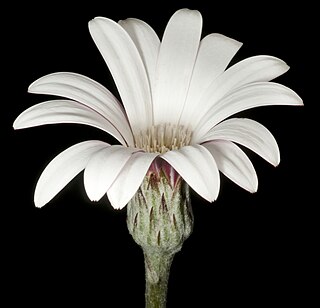
Trichocline spathulata is a plant in the daisy family, found in the south-west of Western Australia.


















